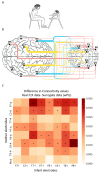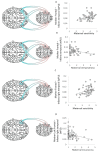Mother-Infant Brain-to-Brain Synchrony Patterns Reflect Caregiving Profiles
- PMID: 36829560
- PMCID: PMC9953313
- DOI: 10.3390/biology12020284
Mother-Infant Brain-to-Brain Synchrony Patterns Reflect Caregiving Profiles
Abstract
Biobehavioral synchrony, the coordination of physiological and behavioral signals between mother and infant during social contact, tunes the child's brain to the social world. Probing this mechanism from a two-brain perspective, we examine the associations between patterns of mother-infant inter-brain synchrony and the two well-studied maternal behavioral orientations-sensitivity and intrusiveness-which have repeatedly been shown to predict positive and negative socio-emotional outcomes, respectively. Using dual-electroencephalogram (EEG) recordings, we measure inter-brain connectivity between 60 mothers and their 5- to 12-month-old infants during face-to-face interaction. Thirty inter-brain connections show significantly higher correlations during the real mother-infant face-to-face interaction compared to surrogate data. Brain-behavior correlations indicate that higher maternal sensitivity linked with greater mother-infant neural synchrony, whereas higher maternal intrusiveness is associated with lower inter-brain coordination. Post hoc analysis reveals that the mother-right-frontal-infant-left-temporal connection is particularly sensitive to the mother's sensitive style, while the mother-left-frontal-infant-right-temporal connection indexes the intrusive style. Our results support the perspective that inter-brain synchrony is a mechanism by which mature brains externally regulate immature brains to social living and suggest that one pathway by which sensitivity and intrusiveness exert their long-term effect may relate to the provision of coordinated inputs to the social brain during its sensitive period of maturation.
Keywords: hyperscanning; inter-brain synchrony; intrusiveness; maternal sensitivity; social brain; social neuroscience.
Conflict of interest statement
The authors declare no conflict of interest.
Figures


Similar articles
-
Sensitive infant care tunes a frontotemporal interbrain network in adolescence.Sci Rep. 2024 Sep 30;14(1):22602. doi: 10.1038/s41598-024-73630-2. Sci Rep. 2024. PMID: 39349700 Free PMC article.
-
Technologically-assisted communication attenuates inter-brain synchrony.Neuroimage. 2022 Dec 1;264:119677. doi: 10.1016/j.neuroimage.2022.119677. Epub 2022 Oct 13. Neuroimage. 2022. PMID: 36244598
-
Specifying the neurobiological basis of human attachment: brain, hormones, and behavior in synchronous and intrusive mothers.Neuropsychopharmacology. 2011 Dec;36(13):2603-15. doi: 10.1038/npp.2011.172. Epub 2011 Aug 31. Neuropsychopharmacology. 2011. PMID: 21881566 Free PMC article.
-
Mother-child behavioral and physiological synchrony.Adv Child Dev Behav. 2020;58:163-188. doi: 10.1016/bs.acdb.2020.01.006. Epub 2020 Jan 27. Adv Child Dev Behav. 2020. PMID: 32169195 Review.
-
A dual-brain therapeutic approach using noninvasive brain stimulation based on two-person neuroscience: A perspective review.Math Biosci Eng. 2024 Mar 4;21(4):5118-5137. doi: 10.3934/mbe.2024226. Math Biosci Eng. 2024. PMID: 38872529 Review.
Cited by
-
Communicative signals during joint attention promote neural processes of infants and caregivers.Dev Cogn Neurosci. 2024 Feb;65:101321. doi: 10.1016/j.dcn.2023.101321. Epub 2023 Dec 6. Dev Cogn Neurosci. 2024. PMID: 38061133 Free PMC article.
-
Sensitive infant care tunes a frontotemporal interbrain network in adolescence.Sci Rep. 2024 Sep 30;14(1):22602. doi: 10.1038/s41598-024-73630-2. Sci Rep. 2024. PMID: 39349700 Free PMC article.
-
Attachment Reminders Trigger Widespread Synchrony across Multiple Brains.J Neurosci. 2023 Oct 25;43(43):7213-7225. doi: 10.1523/JNEUROSCI.0026-23.2023. Epub 2023 Oct 9. J Neurosci. 2023. PMID: 37813569 Free PMC article.
-
Infants' brain responses to social interaction predict future language growth.Curr Biol. 2024 Apr 22;34(8):1731-1738.e3. doi: 10.1016/j.cub.2024.03.020. Epub 2024 Apr 8. Curr Biol. 2024. PMID: 38593800 Free PMC article.
-
Towards a comprehensive approach to mentalization-based treatment for children with autism: integrating attachment, neurosciences, and mentalizing.Front Psychiatry. 2023 Nov 30;14:1259432. doi: 10.3389/fpsyt.2023.1259432. eCollection 2023. Front Psychiatry. 2023. PMID: 38098626 Free PMC article.
References
-
- Ainsworth M.D.S., Blehar M.C., Waters E., Wall S. In: Patterns of Attachment: A Psychological Study of the Strange Situation. Hillsdale N.J., editor. Lawrence Erlbaum Associates; New York, NY, USA: 1978.
-
- van Ijzendoorn M., Kroonenberg P.M. Cross-Cultural Patterns of Attachment: A Meta-Analysis of the Strange Situation. Child Dev. 1988;59:147. doi: 10.2307/1130396. - DOI
-
- Stams G.-J.J.M., Juffer F., van Ijzendoorn M.H. Maternal sensitivity, infant attachment, and temperament in early childhood predict adjustment in middle childhood: The case of adopted children and their biologically unrelated parents. Dev. Psychol. 2002;38:806–821. doi: 10.1037/0012-1649.38.5.806. - DOI - PubMed
Grants and funding
LinkOut - more resources
Full Text Sources

